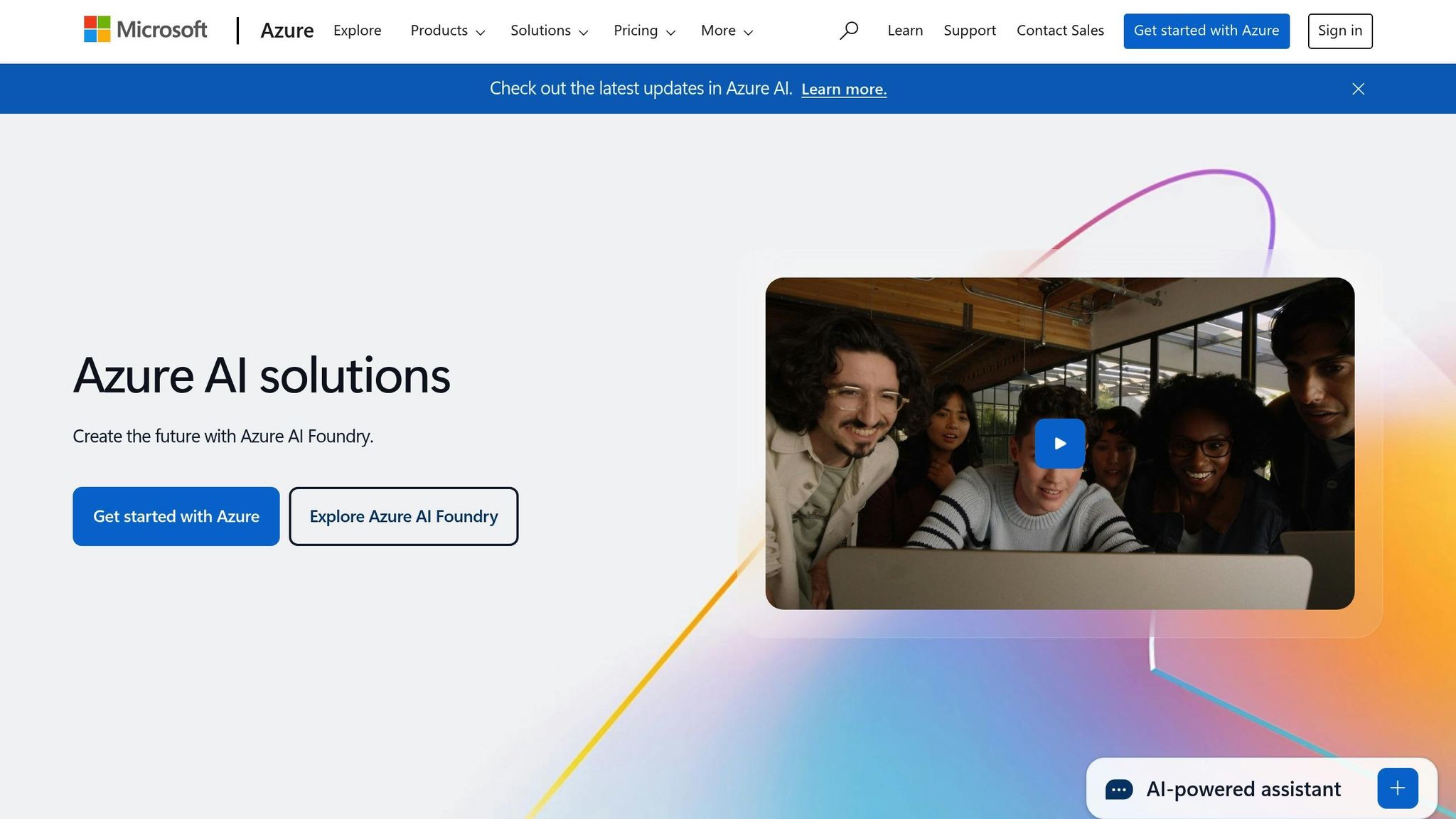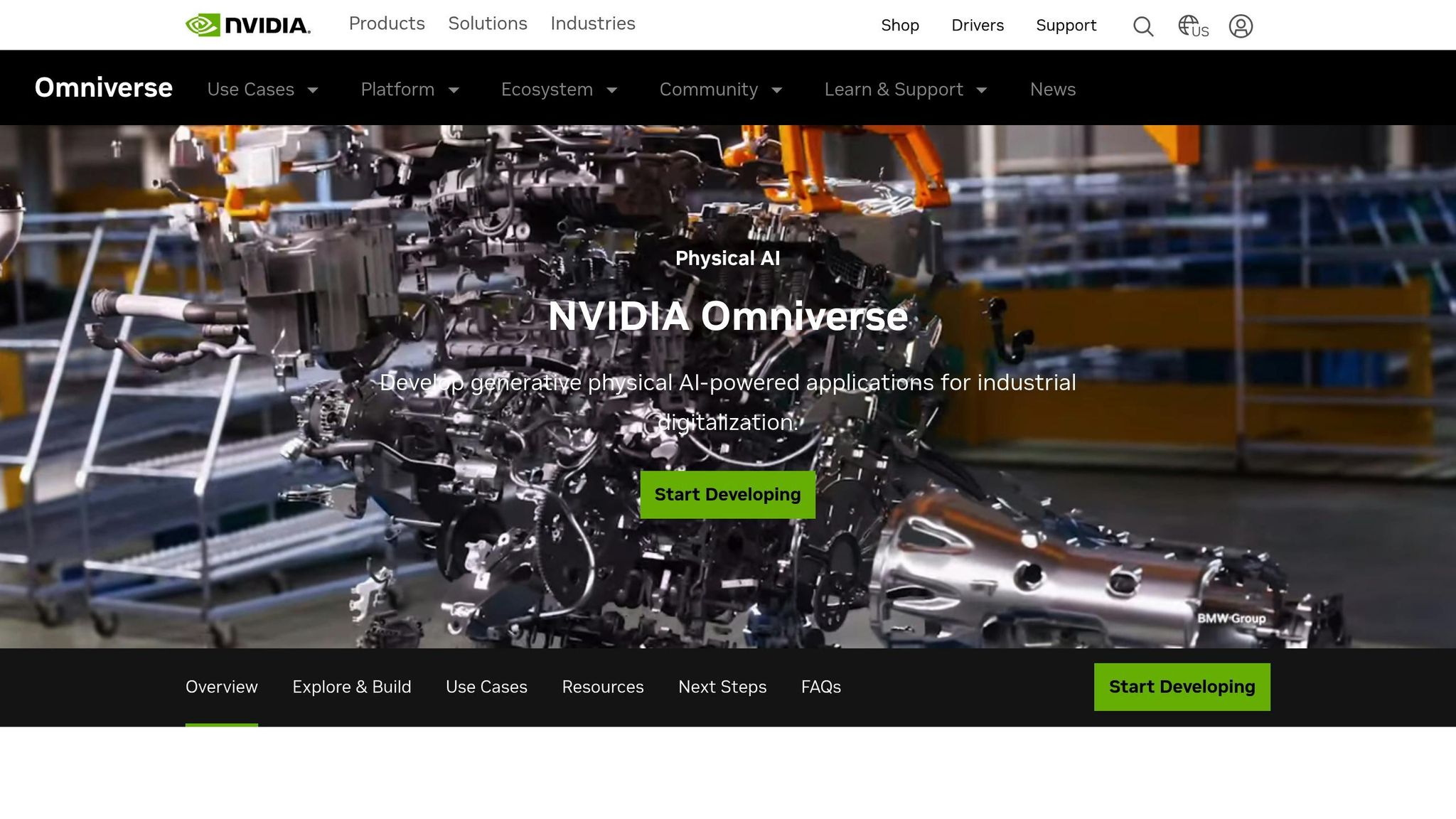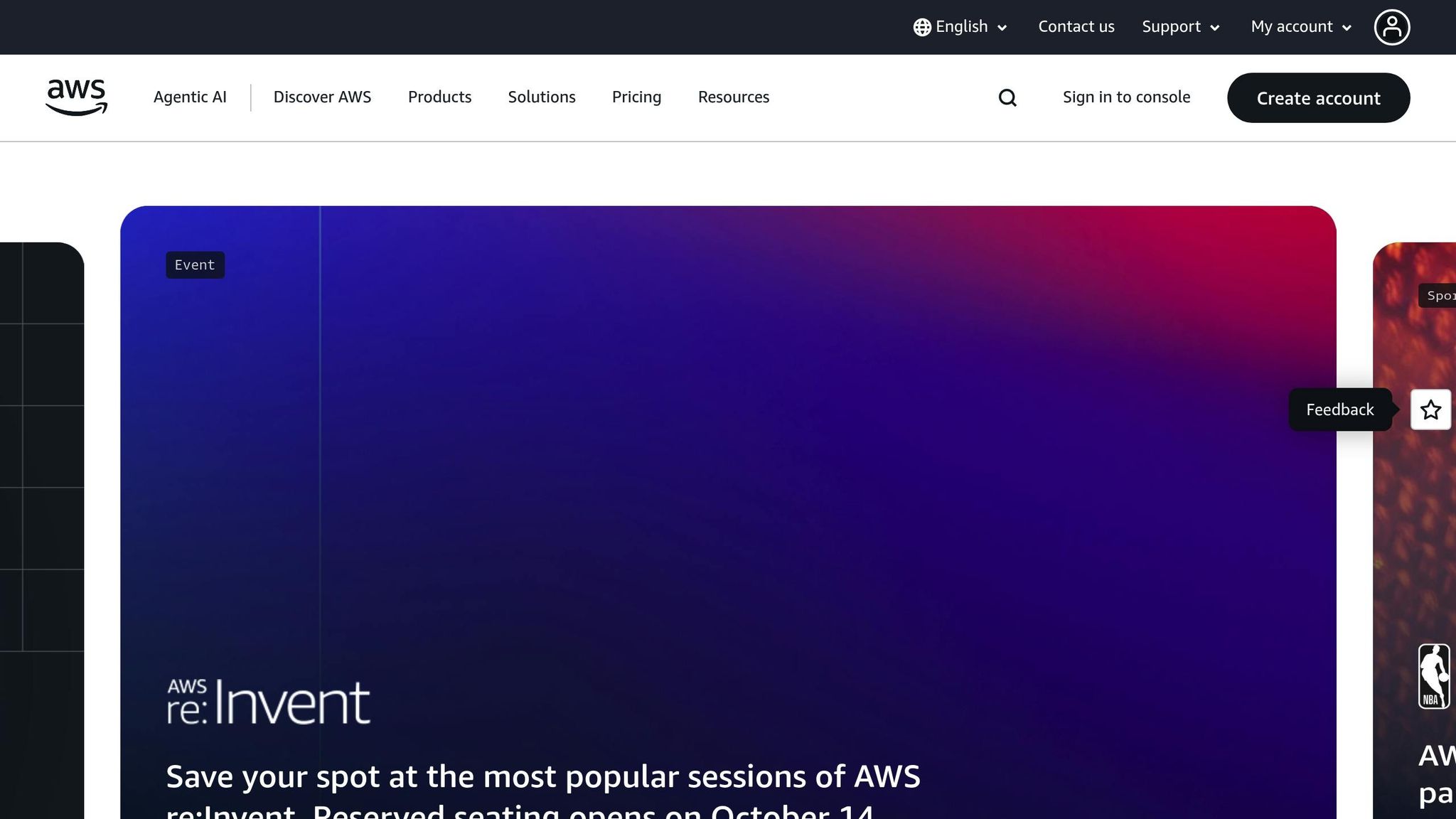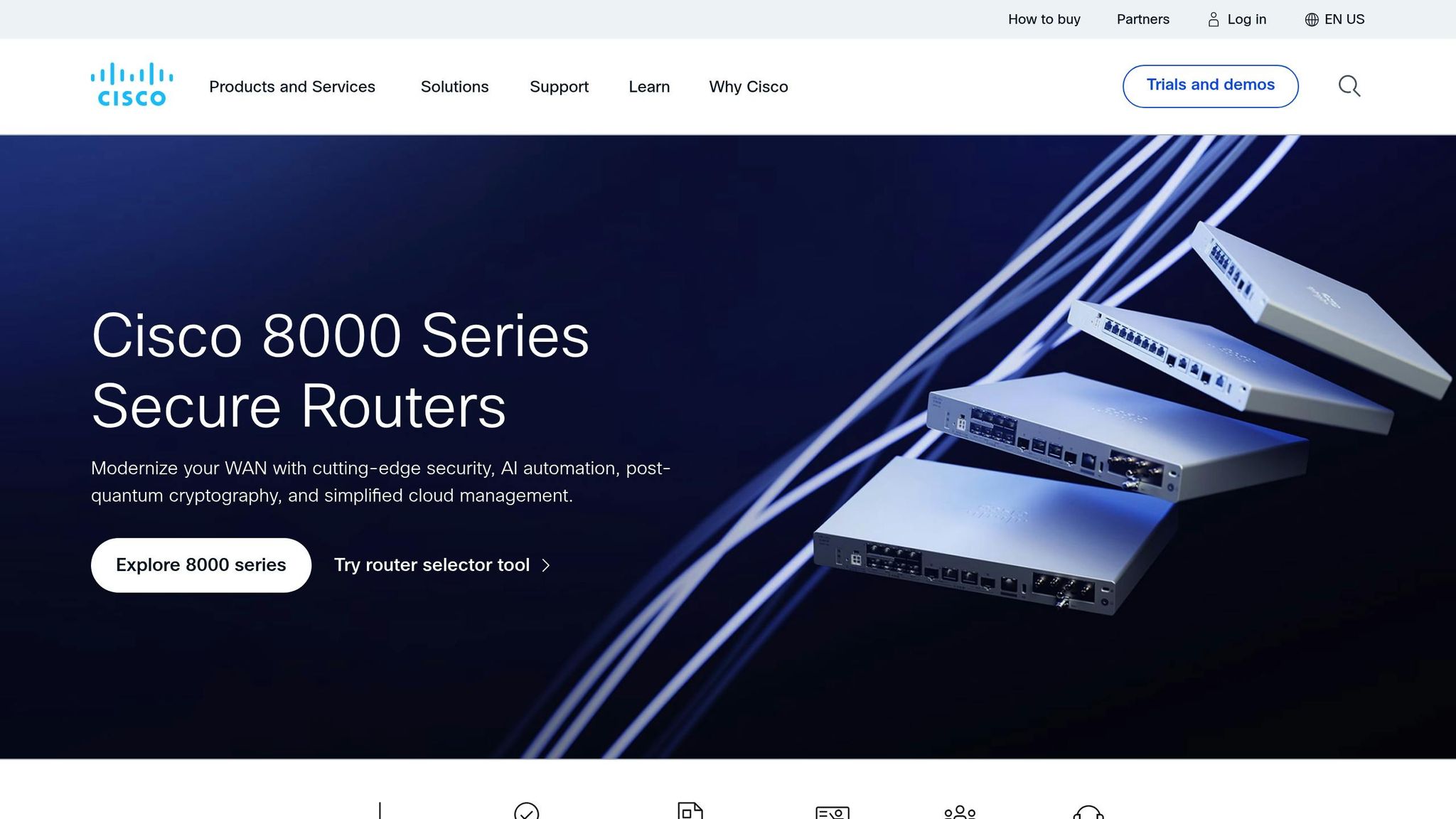
AI command centers are transforming how businesses manage artificial intelligence. These platforms centralize tools, automate workflows, and cut costs, enabling teams to oversee operations efficiently. Five companies stand out in this space, each offering unique strengths:
Each platform has distinct features, strengths, and trade-offs, making it essential to align choices with business goals.
| Company | Strength | Best For | Limitation | Cost Model |
|---|---|---|---|---|
| Prompts.ai | Cost control, model diversity | Budget-focused teams | Limited enterprise features | Pay-as-you-go credits |
| Microsoft Azure AI | Microsoft integration | Businesses in the MS ecosystem | Vendor lock-in risk | Subscription-based |
| Nvidia Omniverse | Real-time visual collaboration | Creative and engineering industries | Not suitable for text-based AI | License-based |
| AWS | Comprehensive AI ecosystem | Large enterprises with complex needs | Steep learning curve, complex pricing | Usage-based |
| Cisco Systems | Network security integration | Security-driven enterprises | Overly complex for simple setups | Enterprise licensing |
The right choice depends on your priorities - cost, security, scalability, or specific technical needs.

Prompts.ai brings together over 35 leading large language models, including GPT-5, Claude, LLaMA, Gemini, Grok-4, Flux Pro, and Kling, into a single, secure platform. Designed for Fortune 500 companies, creative agencies, and research labs, it eliminates tool overload, ensures governance, and slashes AI costs by up to 98%.
One of its standout features is how effortlessly it integrates different models. Prompts.ai consolidates multiple language models into one centralized system, allowing teams to switch between them and compare their performance side-by-side. This eliminates the hassle of juggling separate accounts, APIs, or billing systems. With this unified setup, organizations can securely and compliantly deploy any top-tier model across their teams.
The platform turns scattered, one-off experiments into structured, repeatable processes. By automating workflows, Prompts.ai standardizes prompt management across departments, simplifies model selection, and optimizes costs. This streamlined approach helps teams innovate more effectively.
Prompts.ai introduces a FinOps layer that tracks every token in real time, offering complete visibility into AI spending. Instead of recurring subscription fees, its Pay-As-You-Go TOKN credits system aligns costs directly with usage. This flexible model allows organizations to scale AI operations without worrying about surprise expenses. On top of that, strong data protection measures are built into the platform.
Every workflow is equipped with enterprise-grade security, ensuring sensitive data stays under the organization’s control. Comprehensive audit trails document every AI interaction, supporting compliance and governance requirements. This approach safeguards confidential information while enabling powerful AI-driven solutions.
Prompts.ai encourages teamwork with its global network of prompt engineers and pre-built "Time Savers" that can be implemented instantly. To help organizations build in-house expertise, the platform offers a Prompt Engineer Certification program, promoting best practices. Its intuitive interface ensures accessibility for users without technical expertise, allowing teams to quickly add new models, users, and workflows in just a few minutes.

Microsoft Azure AI, a key component of Microsoft's cloud platform, empowers businesses to build, deploy, and manage AI solutions within a single, cohesive ecosystem. Designed to simplify AI initiatives, it ensures smooth development, deployment, and scaling processes, all while maintaining a strong focus on security, compliance, and operational efficiency. This platform provides an efficient and secure way to incorporate AI into current workflows, helping organizations optimize their operations. Up next, we’ll dive into Nvidia Omniverse's approach to orchestrating AI workflows.

Nvidia Omniverse stands out as a real-time collaboration and simulation platform designed to streamline AI workflows. Built on Nvidia's Universal Scene Description (USD) framework, it creates a unified workspace where teams can work together on AI projects while seamlessly integrating various software tools.
Omniverse bridges over 40 industry-standard applications, including Autodesk Maya, Blender, Adobe Substance, and Unreal Engine, alongside Nvidia's own AI frameworks like CUDA, cuDNN, and TensorRT. This integration allows for real-time collaboration and automatic updates across tools, ensuring that changes made in one application are instantly reflected in others.
For example, data scientists can train machine learning models while designers simultaneously visualize the outcomes in real time. This continuous feedback loop speeds up development cycles and fosters a more efficient workflow. The USD-based architecture at its core ensures seamless synchronization, making it easier to automate processes and streamline AI operations.
Through Nvidia's Omni.Replicator, Omniverse simplifies synthetic data generation and supports batch rendering, simulation, and AI model deployment via TensorRT optimization - all powered by Omniverse Cloud.
The platform can automatically generate millions of labeled images, 3D scenes, and sensor data points. Teams can schedule batch processes to run simulations overnight, ensuring results are ready for review the following day. This level of automation significantly reduces manual effort and accelerates project timelines.
Omniverse fosters teamwork by enabling multiple users to edit projects simultaneously, with real-time updates reflected across all connected workstations. It includes built-in features such as voice and video chat, annotation tools, and version control systems to track every change made during the project lifecycle.
At the heart of this collaborative ecosystem is the Omniverse Nucleus server, which serves as a central hub for managing file sharing, user permissions, and project synchronization. Teams can review AI model performance, tweak parameters, and visualize outcomes together in shared virtual environments. The platform’s user-friendly interface ensures that even those without technical expertise can contribute meaningfully to AI projects.
Additionally, Omniverse supports remote collaboration through cloud instances, using automatic bandwidth and latency optimization to provide a smooth experience for distributed teams.

Amazon Web Services (AWS) offers an all-encompassing AI command center through its suite of machine learning and artificial intelligence tools. Combining a powerful computing infrastructure with accessible features, AWS empowers both technical teams and business users to scale AI solutions effectively.
AWS excels at connecting various AI services and third-party tools through APIs. It integrates seamlessly with popular development frameworks such as TensorFlow, PyTorch, and Apache MXNet. For containerized applications, AWS supports deployment via Amazon Elastic Kubernetes Service (EKS) and AWS Fargate.
At the heart of its machine learning ecosystem is Amazon SageMaker, which acts as a central hub for managing workflows. SageMaker connects to data sources like Amazon S3, Amazon Redshift, and external databases, while AWS Glue processes data from multiple sources directly into machine learning models - eliminating the need for complex migrations.
AWS Lambda adds automation to the mix by enabling event-driven actions. For instance, a computer vision model detecting anomalies in manufacturing images can trigger notifications through Amazon SNS, update records in Amazon RDS, and generate visual reports in Amazon QuickSight - all without manual intervention.
AWS simplifies AI processes through automation tools like Amazon SageMaker Pipelines, which handle everything from data preparation to model deployment. These workflows can be scheduled or triggered by specific events.
For continuous integration and deployment (CI/CD), AWS CodePipeline integrates with SageMaker to streamline model updates. When data scientists modify model code, the system automatically tests, validates, and deploys the new version, ensuring smooth transitions to production environments.
Amazon EventBridge further enhances automation by connecting AWS services with third-party applications. Teams can configure rules to scale resources dynamically, archive outdated data to cost-efficient storage, or alert stakeholders when performance metrics dip below set thresholds. Such integrations create a cohesive ecosystem for managing AI operations.
AWS offers tools like AWS Cost Explorer and AWS Budgets to provide a clear view of AI infrastructure spending. These tools break down expenses by service, project, and time period, helping teams identify costly operations and adjust resource allocation accordingly.
Amazon SageMaker supports several pricing models, including on-demand instances for experimentation and reserved instances for predictable workloads. Spot Instances are also available for training jobs, significantly reducing costs compared to standard on-demand pricing.
To prevent unexpected charges, teams can use AWS Lambda to monitor spending and automatically shut down unused resources. This feature is particularly helpful for avoiding unnecessary costs from idle development instances or prolonged training jobs.
AWS prioritizes security with features like Identity and Access Management (IAM) and AWS Key Management Service (KMS), which ensure secure access to resources and data encryption. Data is encrypted both in transit and at rest, with options for customer-managed encryption keys.
Amazon Macie enhances data protection by identifying and classifying sensitive information, aiding organizations in meeting compliance standards such as GDPR and HIPAA. For audit purposes, AWS CloudTrail logs all API calls and user activities, providing a detailed trail for compliance reporting. This is especially beneficial for industries with strict regulations requiring robust data handling and governance.
Beyond its technical capabilities, AWS fosters collaboration through SageMaker Studio, a web-based integrated development environment. Teams can work on shared notebooks, exchange datasets, and review model results in real time, making teamwork seamless.
The SageMaker Model Registry acts as a centralized repository for trained models, allowing teams to version, reuse, and deploy proven solutions across multiple projects. Data scientists can compare performance metrics and apply the most effective models to new challenges.
AWS Organizations adds another layer of usability by enabling centralized management across multiple accounts. Teams can maintain separate environments for development, testing, and production while managing billing and security policies from one place, streamlining operations across the board.

Cisco Systems brings decades of expertise in network management and security to the table, integrating AI workflows seamlessly into enterprise IT environments. Their approach focuses on blending AI operations with existing IT infrastructures, ensuring compatibility, streamlined automation, strong security measures, and smooth collaboration. This strategy aligns closely with the advanced command centers mentioned earlier, combining Cisco's network management strengths with AI workflow integration.
Cisco's network solutions are built to work effortlessly with both on-premises and cloud-based infrastructures. By prioritizing standardized interfaces and unified policy enforcement, Cisco makes it straightforward for organizations to incorporate AI workloads into their existing systems without disruption.
Automation is at the heart of Cisco's strategy. Their solutions simplify tasks like network provisioning, real-time configuration adjustments based on performance analytics, and resource management. These features ensure AI applications run smoothly without requiring constant manual intervention, keeping operations efficient and reliable.
Security remains a cornerstone of Cisco's offerings. By employing a zero-trust framework, granular access controls, and continuous monitoring, Cisco safeguards AI infrastructures against potential threats. Additionally, the company provides tools that simplify compliance monitoring and reporting, helping organizations navigate strict regulatory requirements with ease.
Cisco understands that successful AI operations thrive on effective teamwork. To support this, they offer intuitive dashboards and collaboration tools, allowing teams to monitor system performance, resolve issues collectively, and manage AI workflows with greater efficiency. This emphasis on user-friendly, secure, and collaborative solutions underscores Cisco's leadership in AI workflow orchestration.
Each AI command center has its own strengths and weaknesses. Knowing these trade-offs can help businesses choose the platform that best aligns with their goals and technical setup.
Prompts.ai is a standout choice for cost-conscious organizations, offering access to over 35 top large language models through a single interface. Its pay-as-you-go TOKN credit system is designed to help businesses manage AI expenses effectively. However, as a relatively new player in the enterprise AI space, it may lack the deep integrations and established support networks that larger, more seasoned providers offer.
Microsoft Azure AI shines with seamless integration into the Microsoft ecosystem, making it a natural fit for companies already using Office 365, Teams, or Azure. With Microsoft's significant investments in research and development, as well as enterprise-grade security, it’s a solid option for organizations prioritizing these features. On the downside, its reliance on the Microsoft ecosystem can lead to vendor lock-in, and costs can be higher for those not already tied to Microsoft services.
Nvidia Omniverse is tailored for industries that require advanced visual computing, such as 3D modeling, simulations, and digital twins. Its expertise in GPU optimization and real-time collaboration makes it a favorite among creative and engineering teams. However, this focus on visual workloads makes it less suitable for text-based AI projects or businesses without significant visual computing needs.
Amazon Web Services (AWS) is known for its extensive cloud infrastructure and mature AI ecosystem, backed by years of enterprise experience. With a wide range of third-party integrations and a robust marketplace of AI tools, AWS is ideal for large organizations with complex requirements. That said, its intricate pricing models and steep learning curve can pose challenges for smaller businesses or those new to cloud-based AI.
Cisco Systems excels in network security and IT integration, making it a top choice for organizations with demanding security needs or hybrid cloud setups. Its zero-trust framework and granular access controls deliver enterprise-grade protection. However, Cisco’s solutions can be overly complex for simpler AI deployments and may involve higher implementation costs.
The following table provides a quick comparison of each platform’s main features, target users, limitations, and cost structures:
| Company | Primary Strength | Best For | Main Limitation | Cost Structure |
|---|---|---|---|---|
| Prompts.ai | Cost optimization & model diversity | Cost-conscious organizations | Limited enterprise features as a newer platform | Pay-as-you-go credits |
| Microsoft Azure AI | Enterprise integration & ecosystem | Microsoft-centric businesses | Vendor lock-in risk | Subscription-based |
| Nvidia Omniverse | Visual computing & simulation | Creative and engineering teams | Not ideal for text-based AI | License-based |
| Amazon Web Services | Comprehensive cloud infrastructure | Large enterprises with complex needs | Complex pricing and steep learning curve | Usage-based |
| Cisco Systems | Network security & IT integration | Security-focused organizations | Overly complex for simpler deployments | Enterprise licensing |
Ultimately, the right platform depends on what a business values most. Companies aiming to control costs and access multiple models might lean toward Prompts.ai. Those needing tight enterprise integration could prefer Microsoft Azure AI or AWS. Nvidia Omniverse is unmatched for visual computing, while Cisco Systems is indispensable for security-driven enterprises.
Deployment complexity also varies. Platforms like Prompts.ai and Microsoft Azure AI are generally easier to set up, whereas AWS and Cisco Systems often require more technical expertise. Nvidia Omniverse falls somewhere in the middle, depending on the complexity of the visual workloads involved.
When it comes to scaling, AWS provides flexibility for diverse workloads, while Prompts.ai offers a budget-friendly approach with its credit system. Microsoft Azure AI scales effectively within its ecosystem, Nvidia Omniverse excels in scaling for visual computing needs, and Cisco Systems ensures robust scaling for network-integrated AI projects.
Prompts.ai simplifies AI management with its pay-as-you-go TOKN credit system, granting access to over 35 top language models through a unified interface. Microsoft Azure AI integrates effortlessly with Office 365, Teams, and Azure infrastructure, making deployment straightforward and reducing training expenses. For industries focused on 3D modeling and real-time collaboration, Nvidia Omniverse stands out with its visual computing capabilities. Amazon Web Services offers a robust cloud infrastructure paired with a vast third-party marketplace, catering to complex enterprise requirements. Meanwhile, Cisco Systems ensures enterprise-grade security with its zero-trust frameworks, tailored for regulated industries.
These platforms highlight how selecting the right AI command center depends on aligning technical demands with business goals. Organizations prioritizing cost efficiency can benefit from Prompts.ai's transparent pricing. Security-conscious businesses in regulated sectors may find Cisco's features indispensable. Creative and engineering teams needing advanced visual tools should explore Nvidia Omniverse, while large enterprises with intricate integration needs might lean toward AWS or Microsoft Azure AI.
Scalability and deployment complexity also play a key role in decision-making. Smaller businesses or those new to AI may prefer Prompts.ai or Microsoft Azure AI for their straightforward setup. On the other hand, larger organizations with dedicated IT resources might opt for AWS or Cisco for their more extensive capabilities. Ultimately, the ideal AI command center balances current requirements with long-term objectives, focusing on cost, security, and compatibility with existing technology for most U.S. businesses.
AI command centers, such as Prompts.ai, help organizations cut costs and improve efficiency by providing centralized control and real-time insights into AI operations. This approach reduces wasteful spending and enhances budget oversight.
These platforms excel at optimizing how resources are used, automating routine tasks, and simplifying workflows. As a result, businesses can lower expenses tied to infrastructure, software, and staffing. By boosting operational efficiency and getting the most out of AI investments, they enable companies to accomplish more while using fewer resources.
When selecting an AI command center, it's essential to align its capabilities with your industry's unique demands. For instance, manufacturing often prioritizes real-time analytics and automation, while sectors like healthcare and finance place a strong emphasis on data security and regulatory compliance. The ability to scale is equally important, ensuring the system can manage increasing data volumes and complexity as your operations grow.
It's also vital to choose a solution that integrates smoothly with your current systems and adapts to changing workflows. By tailoring the platform to your specific operational goals, you can enhance decision-making, streamline processes, and achieve more effective results for your business.
Prompts.ai places a strong focus on security and compliance, embedding features like real-time threat detection, data protection, and regulatory tools directly into its workflow platform. These built-in safeguards protect sensitive information while adhering to industry standards and legal obligations.
With advanced monitoring capabilities, the platform actively addresses vulnerabilities, such as prompt injection attacks, and ensures the secure management of large language models. This forward-thinking strategy empowers organizations to operate AI systems securely, efficiently, and in full compliance, even as they scale.


